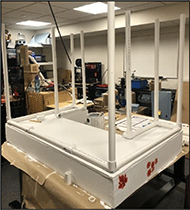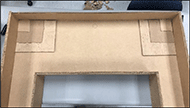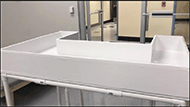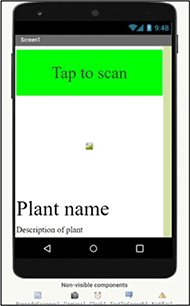Delaney Batik, Catherine Colpoys, Emma Naegler, Olivia Shope
Problem Statement/Research Question and Background

It is often difficult for individuals who use wheelchairs or walkers to garden without complications. Individuals with cognitive impairments may also have difficulty gardening because they often struggle with sequencing and structure. Therefore, the premise of our design is to create an adapted garden bed that is accommodating for individuals who use assistive mobility devices and/or those who have a cognitive impairment.
Methods/Approach/Solutions Considered

We started by researching various types of elevated garden beds and thought about how it would fit a person's needs in a wheelchair. We considered a turntable option, where the individual could wheel up to the garden bed and rotate it, however we ultimately decided to make the garden bed a U shape, so that the individual could wheel inside of it and have the garden be on all three sides. We also considered to make the garden bed slanted so that the water could properly drain, but soon realized that it would not be structurally sound because of the weight distribution. So, we decided to add layers inside the base of the garden bed to allow the water to drain towards the middle. We thought about how to make the height of the garden bed adjustable, because individuals have different sized wheelchairs and we would like it to suit the needs of everyone. We decided to use PVC pipe, so that we could create adjustable legs for the user. For the cognitive aspect, we considered that the individual might need reminders throughout the day on when to water their plants. Individuals with cognitive impairments have difficulty with sequencing, therefore we designed an app to accompany the garden bed that instructs the user on how to properly care for their plants and reminds them when to water.
Description of Final Approach and Design


C.O.D.E. Green is a raised garden bed that includes several technological features that allow users to manage an assortment of flowers, herbs and vegetables in a clinical setting or home. This adapted garden bed is raised to accommodate for wheelchair or walker users and allows for individuals to wheel right inside of the U-shaped design. There are adjustable legs made of PVC piping, so that the user can change the height of the garden bed to suit their needs. The design also includes moisture sensors that detect the moisture levels of the soil while notifying the individual when and when not to water the plants. Users can scan QR codes with a customized app that provides step by step, cognitive friendly instructions on how to care for each plant while offering additional information on the plant's uses and health benefits. There are 3D printed garden signs included as well. Overall, the design includes components of cardboard carpentry, PVC construction, 3D printing, use of Arduino microprocessor, and MIT App Inventor coding.
Outcome (Results of any outcomes testing and/or user feedback)


The design is structurally sound and allows for the water to drain in the center of the garden bed. However, the user must remember not to overfill the garden with soil. The user must also line the inside of the garden bed with plastic and remember to check the moisture sensor to know when their plants need watering. The garden bed should be placed in a spot where the plants can get sunlight and where a person in a wheelchair will be able to easily access the garden.
Cost (Cost to produce and expected pricing)


The PVC piping cost approximately $15.00, the Arduino cost approximately $100.00, and the paint/varnish cost approximately $20.00. In total, this design costs about $135.00 to produce, however it would be sold at a much lower price.
Significance
Individuals in a wheelchair or individuals that have a cognitive impairment could benefit greatly from C.O.D.E. Green if gardening is something they are passionate about. C.O.D.E. Green works to promote motor and processing skills, including gripping, pacing, and sequencing. C.O.D.E. Green also increases an individual's independence while providing an opportunity for social interaction and increased healthy living. With C.O.D.E Green, there are no limits to the growth that can be achieved.
Acknowledgements and References
Das, B., & Kozey, J. W. (1999). Structural anthropometric measurements for wheelchair mobile adults. Applied Ergonomics, 30(5), 385–390. https://doi.org/10.1016/s0003-6870(99)00010-1